Faustpatrone (Faustpatrone) - RPG "Panzerfaust"
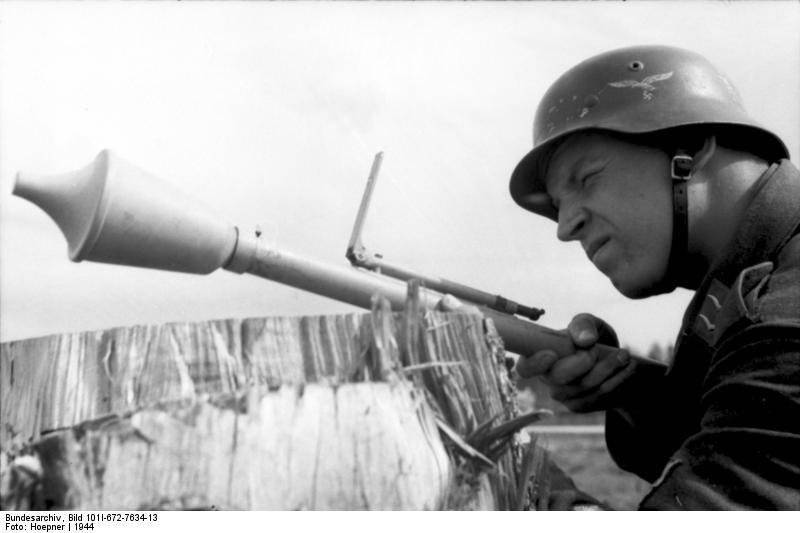
In this regard, the German designers continued research in this direction. The main condition for the new weaponsIn addition to armor penetration of more than 150 millimeters, it was a combination of lightness and high power inherent in recoilless systems. In addition, they sought to reduce the cost of production by means of the widespread introduction of non-deficient materials and stamped-welded structures. A real breakthrough in this area was the proposal of an engineer, Dr. Heinrich Langweiler from the HASAG company (Leipzig), who worked on reactive and dynamo-reactive weapons. In the spring of 1942, Langweiler formulated a schematic diagram of a new anti-tank hand weapon that had no recoil at the time of the shot. This weapon was named Faustpatrone 1 ("Faustpatron" - fist cartridge). This name later became common to all samples of dynamo-reactive anti-tank grenade launchers (RPGs) of Germany. In addition, a new weapon for a long time called him the unofficial nickname "Gretchen." Faustpatrone 1 was one of the first in the series of so-called "miracle weapons", developed by the designers of the gunsmiths of Germany during the Second World War.
For the first time in one design, a fairly effective warhead of the cumulative 3,7 cm Stiel-Gr cumulative grenade was connected. Patr.41 and rocket engine (powder charge), placed in the barrel. The use in this weapon of ammunition having a low initial speed and a reduction in recoil to an acceptable level for the shooter allowed us to create a sample that allowed steady fire, both from the machine tool and from the hand. This one-shot grenade launcher, which is essentially a reactive anti-tank grenade, consisted of two parts (mainly manufactured by cold forming): an over-caliber cumulative grenade with a tail stabilizer and a hollow tube open to both sides (length 360 mm) containing gunpowder propellant charge. The grenade was inserted into the trunk from the front. On the trunk going trigger. Part of the powder gases during the shot at the open barrel was retracted, thus creating a forward-directed reactive force balancing recoil force. "Faustpatron" served by one person. But since when firing a beam (force) of a flame from a burning charge arose, the grenade launcher had to hold a new weapon at arm's length. This situation significantly reduced the accuracy of aiming. This design affected the accuracy of the weapon. The first version of the RPG was unsuccessful because of the shortcomings of a grenade, a short range of flight and extremely low accuracy. But despite this, the unification of low-speed cumulative ammunition in one weapon and the lack of recoil during the shot promised that this maneuverable and light infantry anti-tank weapon, which allows you to fire from your hand, cheap and easy to manufacture, can revolutionize the military, so as has great potential reserves for further improvement.
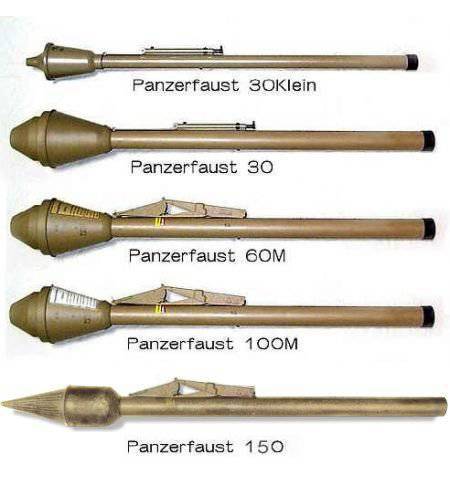
In the fall of 42 - in the winter of 43, Langweiler continued to upgrade his grenade launcher. Already in March 43, the company HASAG handed over to HWaA (Wehrmacht Arms Directorate) an improved version of the Faustpatron - a dynamically active 101-mm hand-held anti-tank grenade launcher Panzerfaust Klein 30M (“armored fist”). The designer made a modification of his grenade launcher, extending the barrel to 800 millimeters, which allowed him to take his arm. The grenade was inserted in the front. The changes were mainly made to the cumulative action of the above-caliber grenade: its caliber was reduced, the head fairing got a new shape, which was more successful, the grenade tail core was replaced with a stem (tube with a wooden tip) with elastic plumage attached to it. The plumage consisted of four folding stabilizers. The stem was threaded with the grenade body. In the body of the grenade there was a discontinuous shaped charge (a mixture of TNT and RDX in the proportion of 40 / 60%). The metal parts of the grenade were made by stamping. 33-mm barrel was a smooth-bore metal pipe. With the help of welding on the barrel fixed shooting spring push-button mechanism and sighting stand. The structure of the firing mechanism includes a tube of a percussion mechanism, a trigger button, a retractable stem with a screw, a sleeve with a primer-igniter and a return spring. The percussion mechanism was installed in two basic positions - on a battle platoon and on a safety device. A propellant charge, consisting of fine-grained smoked gun powder in a cardboard charge of a cylindrical shape, was fastened in the barrel with a screw. A projectile charge was separated from the grenade by plastic wad. Sights - rear and front viewfinder. Instead of a fly, the upper edge of the grenade shell was used. The rear scooter was a figured slot in the sighting flap, hinged to the USM case. For firing in the dark, the front sight and sight were covered with luminescent paint. In the stowed position, the flap, attached to the eye of the grenade by a check and adjacent to the barrel, served as a stop for the grenade and the percussion mechanism. In this position of the aiming bar it is impossible to cock the drummer, since the shutter-release button was closed, and, therefore, the shot was impossible. Grenade launchers were painted yellow-brown or dark green.
Grenade launchers were handed over to the troops assembled, but for firing a shot, it was necessary to first load the Panzerfaust, while loading was done just before combat use. For charging it was necessary, without removing the safety check, to turn the anti-clockwise direction of the grenade body to separate the head part from the stem of the grenade. The stem remained in the barrel of the grenade launcher. A metal cup having a bottom inertial fuse of a non-safety type and a standard detonator kl was inserted into the body pipe. ZdTg.34 Np, 10. Grenade and stabilizer connect the reverse movement. Before the shot, a safety check was removed, which was in front of the barrel. After that, the aiming bar was raised and the impact mechanism was cocked. For cocking, the stem inside the case was fed forward, while the capsule was led to the pilot hole. Then he was pulled back, turned to 90 degrees counterclockwise, removing the mechanism from the fuse. When the shutter release button was pressed, a ray of fire was transmitted from the primer-igniter to the expelling charge. The expelling charge, igniting, threw the grenade out of the barrel.
In order to make a shot, the barrel was wrapped with two hands and, tightly held under the arm, aiming and pressing the trigger was carried out. After the grenade was thrown out of the barrel, the folded stabilizer blades were opened. A jet of powder gases that burst from the open rear end of the barrel and the length of which reached 4 meters, created a danger for the shooter. In this regard, in order to avoid the rebound of the reflected flame of the shooter and other people, as well as combustible materials and ammunition, there should be no obstacles at a distance of 10 meters behind it. The warning “Warning! A strong ray of fire! ”Placed on the trunk. Thus, the use of this weapon had certain restrictions, including the prohibition of use from closed premises. At the moment of the shot, the percussion mechanism of the fuze was activated, which worked during the meeting of the head of the grenade and any obstacle. When fired, the grenade thrower almost did not sense the impact of recoil. After the shot, the launch tube was thrown away, as it was not subject to reloading. If after the drummer was cocked and the trigger was removed from the fuse, there was no need for firing, the grenade launcher could be removed from the platoon and put on the fuse. To do this, you need to lower the aiming bar to the barrel and insert the check back into the cutout at the end of the aiming bar and the eye of the grenade.
The Panzerfaust Klein 30M grenade launchers were transported on 4 pieces in wooden boxes in a not fully equipped form, that is, without detonating devices and fuses placed in cardboard cases separately.
With a grenade launcher mass equal to 3,25 kilograms, its armor penetration on 30 meters was up to 150 millimeters. This was one of the best results for the time, which allowed the German infantry to destroy almost all types of enemy tanks. However, the short range of the grenade made it difficult for Panzerfaust Klein 30M to fire, since the grenade launcher could have perished under the tracks of the armored vehicle. As a result, a new tactic to combat armored vehicles appeared - flank fire was fired at tanks: in settlements - because of structures, in field conditions - from light shelters or trenches.
In August, HASAG 1943, having mastered the mass production of Klein 30M hand-held anti-tank grenade launchers, produced 8,7 thousand pieces. For the first time, Panzerfaust was successfully used in a battle on the Eastern Front on the territory of Ukraine in November 1943. By October, the production of this cheap and at the same time very effective weapon was already 200 thousand pieces. per month. The following figures indicate the success of this anti-tank weapon: in the period from January to April 1944, German infantry on the Eastern Front destroyed 520 tanks in melee combat. In this case, the share of the dynamo-reactive RPG Panzerfaust accounted for 264 units, while of the Ofenrohr RPzB.XNNX hand-held grenade launchers only 43 tanks.
Langweiler grenade launchers had a rare feature - the potential for their further improvement was very broad. The need of the army for more powerful weapons has led to the creation of a modernized 149-mm RPG Panzerfaust 30M. The grenade, whose mass was 2,4 kg, made it possible to penetrate armor with a thickness up to 200 millimeters, with the same firing range - 30 meters. At the beginning of 44, the Faustpatrons were subjected to a radical modernization. This greatly improved the fighting qualities of the grenade launcher, simplified manufacturing, and increased the range of aimed fire to 60 meters. The changes made to the Panzerfaust 149M 60 mm grenade launcher were as follows:
- diameter of the launch tube-barrel increased to 50 millimeters;
- an increase in the wall thickness (throwing tube) of the barrel increased resistance to mechanical damage during transportation and combat operations. In addition, it allowed the use of more powerful powders and also increased the weight of the propellant charge. This increased the initial speed of the grenade from 45 to 60 meters per second;
- a grenade of new construction was connected to the stem with a spring latch, and not a threaded connection. This simplified the loading of weapons and made it possible to install the front sight on the rim of a grenade, allowing more targeted fire from a grenade launcher;
- the push-button percussion mechanism of the early Faustpatrons, which was not entirely successful, was replaced with a simple lever. It installed a new primer-type igniter Zhavelo, which reliably acted in adverse conditions;
- redesigned sight. Now it was designed for three fixed firing ranges - 30, 60 and 80 meters (the first models of grenade launchers had only one fixed range of the sight);
- while maintaining armor penetration (200 millimeters at an angle of 30 degrees), a grenade of increased mass (2,8 kg) could hit armored targets at a distance of up to 80 meters. In addition, an anti-tank grenade launcher could now be used to destroy defenses;
- the mass of the upgraded grenade launcher was 3,3 kg, and the assembled grenade launcher (with a grenade) increased from 5,35 kg to 6,25 kg.
As the experience of the combat use of Panzerfaust increased, the views of the Wehrmacht command on this weapon also changed. In 1943 and at the beginning of 1944, while hostilities were being conducted on the territory of the USSR with its vast territories, the effectiveness of this weapon was insufficient, since the short firing range (up to 60 meters) did not allow the RPG to be widely used in the field. In this regard, the Panzerfaust was in service only with tank destroyers, which ambushed in fortified areas, at bridges, roads, in settlements, etc. And only in the spring and summer of 1944, when the Soviet army entered the territory of densely built-up Eastern Europe, the "Faustpatrones" began to enter service with the German infantry en masse. This dramatic change in the situation was also facilitated by the deployment of large-scale production of RPGs. By the fall of 44, the German military industry was able to establish an ever-growing production of Panzerfaust. In April 1944, production of the Panzerfaust 30M reached 100 units. and Panzerfaust 60M - 200 thousand units. In May - October of the same year, their monthly output was already 400 thousand units, in November - 1,084 million units, and in December this figure was already 1,3 million units. At the same time, the consumption of Panzerfaust 30M and Panzerfaust 60M in November 1944, during the battles in Poland, Prussia and Hungary, amounted to only 209 thousand units. In January - April 45, German enterprises produced more than 2,8 million Faustpatron grenade launchers. Apart from all HASAG factories in Schlieben and Leipzig, other companies were also involved in the production of Faustpatrone. The explosives for these RPGs were produced by: Rheinische Gummi- & Celluloid- Fabrik, Buhrle & Co and Oerlikon, and Volkswagen is one of the largest automobile factories in Germany. Moreover, the need of the German troops for this weapon was so great that the guides of the Panzerfaust, which was a single-use weapon, were not thrown away after use. In combat units, their collection was organized to be sent for reloading with grenades at the factory.
In 1944-1945, Faustpatron was the main TCP of the infantry divisions, the people's grenadier divisions, and also the battalions of the Volkssturm. For example, in the fall of 1944, per kilometer of the front accounted for up to 90 anti-tank grenade launchers Panzerfaust. German infantry companies for each soldier had several grenade launchers, which allowed to significantly strengthen the anti-tank defenses and significantly increased the loss of Soviet troops in armored vehicles. A good example is the fighting on the territory of Poland, Hungary and Germany in the autumn of 44 - in the winter of 45. 26 January 1945, the Supreme Commander of the German Armed Forces A. Hitler ordered the creation of a "tank-fighter division", which were supposed to include companies scooters (cyclists), armed with Panzerfaust.
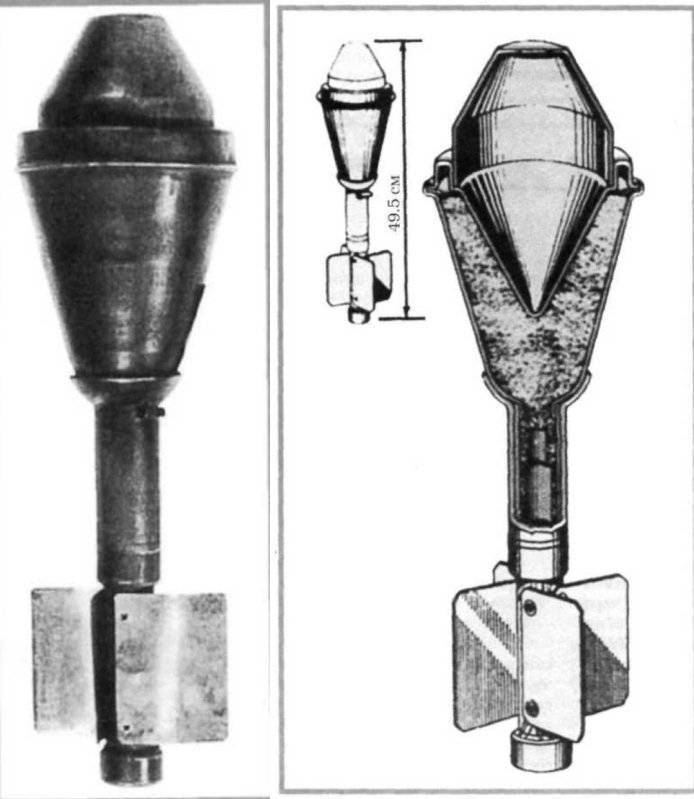
The difficulties of fighting the enemy’s tanks, which the Soviet and Anglo-American forces were fighting to combat the grenade launchers armed with Panzerfaust, again forced the HASAG engineers to upgrade the grenade launchers. In this case, the designers did not focus on the increase in armor penetration, which was 200 mm (quite sufficient for its time), but on the increase in the range of use. In November, the Wehrmacht 1944 received a new RPG model - the 149-millimeter Panzerfaust 100M. In this anti-tank grenade launcher, developers were able to increase the firing range to 100 meters.
The original feature of the Panzerfaust 100M is the presence of a container of propellant charges successively placed in the barrel with an air gap between them. This placement of charges ensured an increase in the pressure of the powder gases, which arose during the ignition of the first charge, influencing, by creating a closed volume with a second charge, an increase in the range of throwing grenades. When shooting grenades, powder gases of the second charge, moving back, balanced the system. Thus, the designers managed to achieve greater stability when shooting, which was reflected in the improvement of accuracy during the battle. Simultaneously with the increase in the range of fire, its armor penetration (up to 240 mm) increased, albeit slightly, which allowed Panzerfaust 100M to become a really serious opponent for all Allied heavy tanks at the final stage of the war.
The high effectiveness of Panzerfaust in the last months of the war significantly increased the losses of allies in armored vehicles, which led to the adoption of countermeasures - the most vulnerable places of combat vehicles were shielded, a new tactic was used to conduct joint actions by infantry and tank units. These changes have significantly reduced the damage inflicted by Hitler’s grenade launchers to armored forces. After the war, Marshal of the Soviet Union I.S. Konev, commander of the First Ukrainian Front, wrote the following about it: “... In an effort to reduce the number of tanks destroyed by faustpatrons, we introduced a simple but very effective means — they created a so-called screen around the tanks: sheet metal or sheets of tin were hung over the armor. Getting to the tank, the faustpron punched at first this insignificant obstacle, however there was a void behind it, and the grenade ran across armor having lost its reactive force. She most often ricocheted, and did not cause damage ... Why did this remedy start to apply so late? This is probably due to the fact that we practically did not encounter such a wide use of faustpatrons during street battles, and we did not take this into account in open areas. ”
But his opponent, Wehrmacht Lieutenant Colonel E. Middeldorf, spoke about this in his memoirs: “A large number of tanks, shot down with anti-tank infantry, speaks for itself ... Most of the downed tanks in the account of Panzerfaust. But “Panzerfaust”, which has a rough guide and great dispersion, gave a good result only when used at a distance of no more than 80 meters ... This fact speaks of the courage of the German soldiers, which they displayed in close combat with tanks. However, you should not overestimate the value of melee. The sharp decline in the results of the fight against tanks with the help of Faustpatrone, which has been observed since January 1945, is primarily due to the introduction by the Russians of new tactics of protection against tank destroyers. It consisted in the protection of armored vehicles during the battle by individual arrows, which moved at a distance of 100 - 200 meters from the tank. If the nature of the terrain did not give the tank destroyer favorable conditions for shelter, the melee became impossible ... This tactic was a response to increasing the effectiveness of anti-tank defense, which was achieved through the use of the new RPGs “Panzerfaust” and “Ofenror”.
The last support of the regime according to the idea of the leadership of the Third Reich was to be the people's militia, which is better known as Volkssturm. More than 4 million people had to get under the gun. For their equipment required a huge number of weapons, which was supposed to be easy to use and cheap to manufacture. At the same time, the weapon must be very effective, such as, for example, Panzerfaust. Under these conditions, the Wehrmacht command faced an almost insoluble problem. On the one hand, it is necessary to encourage and arm a mass of people who have not passed the drill, on the other hand, it was necessary to train them in basic knowledge in military affairs. Naturally, the question arose of how to teach the use of disposable grenade launchers if there is a shortage of them in combat units at the front. Therefore, it was necessary to urgently create an educational version of Faustpatron. 20 November 1944 of the year in all military units of the German army went together with the Chief of the HWaA Armament Service and the Inspector General of the Tank Forces on self-production (according to the attached drawings) a device that allows you to train from Panzerfaust. The training version of Panzerfaust was a barrel-pipe from the 60M grenade launcher, equipped with a special device for shooting a mock-up grenade and a "ray of fire". The device was a chamber under the idler 7,92-millimeter rifle cartridge M.ZZ, which was vertically inserted into the barrel of a grenade launcher. When fired, gunpowder gases pushed the wooden mock-up of the grenade from the barrel-pipe forward and worked on the drummer of the second blank cartridge, which was inserted into the wooden beam of the "ray of fire" that served as anti-mass for the grenade. This device has made its own, though not as significant as it was intended, contribution to the training of the Volkssturm aiming, shooting and choosing a position.
An unambiguous assessment of the use of Panzerfaust’s Volkssturm units in the battles of the last period of the war was given by I.S. Konev: “The battalions of the Volkssturm, in whose ranks teenagers and the elderly prevailed, were especially abundantly supplied with the Faustpatrons. Faustpatron was one of the means that could create a sense of confidence in untrained people and physically untrained people that, only after becoming soldiers, they could do something today. It should be noted that in the majority of cases these faunters fought to the end and showed much greater stamina than the well-worn species, but the German soldiers, cracked by many years of fatigue and defeat. ”
The deterioration of the situation at the front, and the new tactics of the motorized rifle and armored forces of the enemy, which now took into account the wide use of the Wehrmacht Panzerfaust, again demanded that the Germans take measures to neutralize the Allied attempts to minimize losses in tanks and armored vehicles. Therefore, in November 1944 of the year, the HWaA department for the development of jet weapons commissioned HASAG to re-modernize the Panzerfaust design to expand the combat capabilities of the anti-tank grenade launcher. When designing this weapon, new tactical and technical requirements should be taken into account, which included:
- increase the firing range while maintaining the charge and launch tube-trunk Panzerfaust 100M;
- Saving explosives with increasing armor penetration grenades;
- the use of surrogate explosives;
- use in the manufacture of arc and spot welding;
- the possibility of using grenades, both for the destruction of armored targets, and enemy manpower.
In these tactical and technical requirements, in addition to the already established requirements to improve the combat qualities of weapons, as well as reduce the cost of their manufacture, a completely new requirement was voiced - they first formulated the concept of creating a combined cumulative fragmentation grenade (in many countries this concept was approached later by 10 - 15 years). First of all, HASAG engineers began working with a grenade. To increase the firing range, an additional jet engine was introduced into the grenade design. In spite of the fact that this decision allowed to significantly increase the throwing range, a sharp decrease in the accuracy of fire negated all the achieved results. The use of nitrocellulose powders as a propellant charge did not give a positive result either. Measures to reduce the cost of Faustpatron taken by designers, forced them to turn to light metals for the manufacture of trunks, pipes, but these works also did not give positive results. After several unsuccessful experiments, without refusing to make various improvements in his design that did not affect the very foundations of the weapon, the German engineers approached the non-traditional side to solve the problem, giving the Faustpatron a new breath. The designers proposed to make a completely new model - reusable RPG. This solved many problems related to the acute shortage of materials necessary for the production of Faustpatron in the face of the loss of a part of the raw material base and the disintegration of production ties in the Third Reich, and to some extent removed the question of increasing the production of these weapons, so necessary in defensive battles. In the first place, the grenade itself was almost completely recycled. In the new grenade, the warhead, the stabilizer and the bottom fuse were assembled into a single whole (the grenades of the former Panzerfaust consisted of two parts - the warhead and the shank with a feather). This allowed to change the principle of loading a grenade launcher. The stabilizer tube had a retainer which, when loaded, entered the recess of the grenade launcher. This ensured a firm fixation of the combat charge in a hand-held anti-tank grenade launcher and made it possible to safely discharge the weapon if the need for firing was no longer necessary. The launch tube-trunk in this form allowed multiple reloading. Thickening of the barrel walls made it possible to withstand grenade launchers up to 10 shots. The solution to the problem of increasing the firing range also turned out to be quite simple - they improved the aerodynamics of the grenade.
The new hand-held anti-tank grenade launcher, known as the Panzerfaust 150M, but better known as Splitterfaust (fragmentation fist), used a cylindrical conical grenade, with stabilizers and longitudinal grooves on the ballistic cap ensuring its steady flight. Aerodynamics also improved due to the reduction in the diameter of the grenade body from 149 millimeters (in Panzerfaust 100M) to 106 millimeters (in Panzerfaust 150М). Due to this, the maximum firing range of the Panzerfaust 150M was 300 meters, and the effective range was about 150 meters. At the same time, due to minor changes, the efficiency of the grenade has significantly increased. The grenade was equipped with a cylindrical part of the corps with a flip-up front sight, which greatly improved the ability to conduct aimed fire. A grenade wore a steel cylindrical shirt (copied from a RGD-33 hand grenade made in the USSR) with transverse cannels applied to its surface to create slaughter elements that increased the destructive effect of the fragments. This made it possible to wage a successful fight, both with the enemy’s armored vehicles and with his living strength. The new grenade retained the same armor penetration (220 -240 millimeters), which was sufficient to destroy any tanks of that time. In March, 45 of the year HASAG began production of the first installation batch of these anti-tank grenade launchers in the amount of 500 pcs. It was planned that their monthly release in the near future will reach 100 thousand pieces. However, the American troops, capturing Leipzig in mid-April, where the production of the Panzerfaust 150M was launched, stopped the last attempt by the Germans to use the so-called “miracle weapon” and thus increase the number of victims of the war.
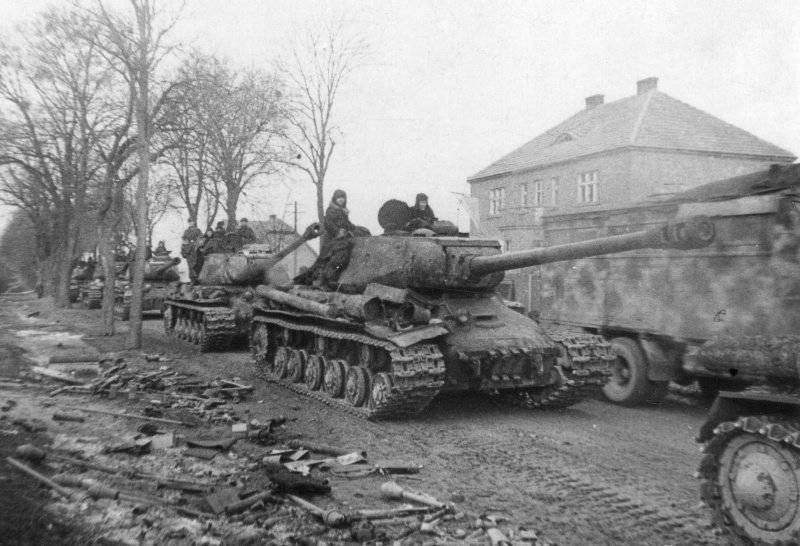
The problem of increasing the effectiveness of Panzerfaust was not only to increase the firing range and armor penetration, but also to improve the accuracy of their combat. In this regard, simultaneously with the creation of the Panzerfaust 150 PTG designers, work was carried out on the next, more powerful, Panzerfaust 250 model, the aimed range of which was 250 meters. Achieved through the use of an elongated launch tube trunk and a larger mass of expelling charge. The use of an electric nozzle instead of a lever trigger made it possible to achieve greater reliability of operation under adverse conditions, especially in the cold season. For the grenade launcher they created a new starting barrel-pipe, on which they fastened with the help of union clamps: the trigger mechanism assembled in a stamped control handle; the frame humeral emphasis made of threw; additional handle hold grenade. Shooting led from the shoulder, similar to the Panzerschreck and Ofenrohr grenade launchers. Such simple adaptations significantly improved the weapon's handling when fired, which, in turn, increased the accuracy of shooting from these grenade launchers. However, the experiments with Panzerfaust 250М, like other similar works, were not brought to the end due to the surrender of Germany.
In January, 1945, Reichsforschungsrat (RFR), the Reich Research Council, and WASAG made another attempt to improve this weapon. The new grenade launcher, known as the Verbesserte Pz.Faust ("improved Panzerfaust"), had a 160-mm grenade with an improved fuse. Already in February, Heber was planning to set up its production in the city of Osterode, but the Allies' rapid offensive prevented the implementation of these plans. However, in the same January of 45, a number of new designs of grenade launchers appeared, including those that can be safely considered fantastic: the Grosse Panzerfaust project - a barrel-pipe from 250M and a new enlarged garnet with armor penetration up to 400 millimeters; Brandfaust - an incendiary Pz.Brandgranate grenade was used; Gasfaust - pomegranate filled with toxic substances; Flammfaust is a disposable flamethrower. The most promising project was the Schrappnell-Faust anti-personnel grenade launcher, with a fragmentation grenade and a range of fire up to 400 meters. The charge was undermined by a mechanical remote fuse at a height of 2 - 3 meters, contributing to the formation of a continuous zone of destruction of enemy forces at a distance of 20 meters. The weight of this weapon was about 8 kilogram. By the spring of 45, a batch of these grenade launchers in the amount of 100 pcs was sent to the military trials. But Schrappnell-Faust was not brought to mass production.
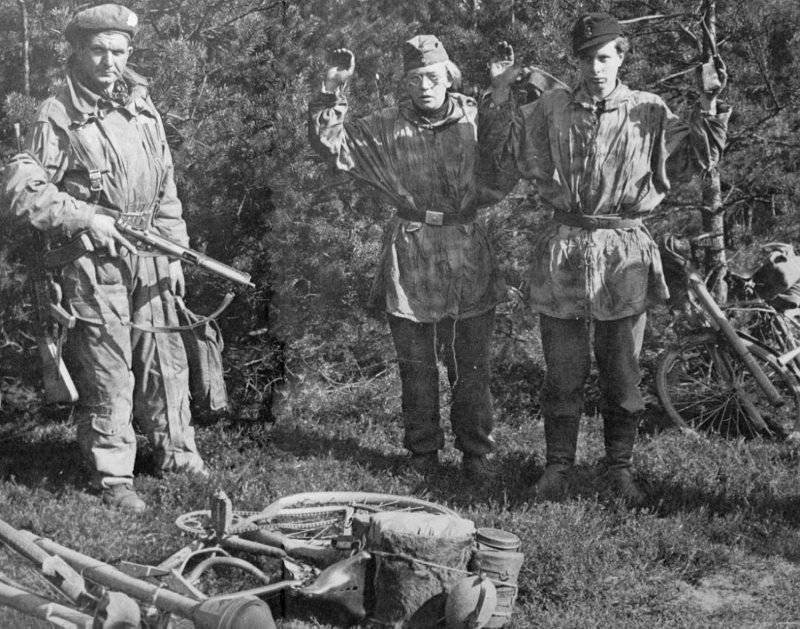
This weapon inflicted huge losses on the Soviet forces in the capital of the Reich, where the Panzerfaust RPGs were in service with all German units and subunits of the Wehrmacht, Volkssturm and SS defending Berlin.
Later I.S. Konev, who was directly involved in these bloody battles, wrote in his memoirs: “... The Germans were preparing Berlin for a tough and solid defense, which was designed for a long time. The defense was built on a system of high fire, resistance nodes and strong points. The closer to the center of Berlin, the denser the defense became. Massive stone buildings with a large thickness of walls, adapted to the long siege. Several fortified buildings thus formed a knot of resistance. To cover the flanks, strong barricades were erected up to 4 meters thick, which were also powerful anti-tank obstacles ... Corner buildings of which could be fired with special targeting and flank fire strengthened especially carefully ... In addition, the German defense units were saturated with a huge number of fausttron cartridges that street fighting became a formidable anti-tank weapon ... Also, Berlin had a lot of anti-aircraft artillery, which during street fighting played a significant role in the VET. If you do not take into account faustprony, then we suffered most of the losses among tanks and self-propelled guns in Berlin from the enemy’s anti-aircraft installations. During the battle for Berlin, the Nazis destroyed and destroyed more than 800 our self-propelled guns and tanks. In this case, the bulk of the losses fell on the battles in the city.
If to evaluate RPGs according to the main criterion “cost-effectiveness”, then Panzerfaust occupies a leading place in the class of infantry weapons of the Second World War. German scientist Hans Curl, a specialist in the military industry, gave these grenade launchers the most accurate assessment: “Perhaps the only weapon in Germany that met the requirements of maximum efficiency with minimal expenditure of funds and forces for its production was Faustpatron.” German rocket launchers were not only the most massive type of Wehrmacht weapons, but the cheapest. 8 man-hours were spent on producing the Faustpatron, and the cost price ranged from 25 to 30 marks, depending on the modification. According to the data compiled by the German Central Statistical Office on the instructions of the Ministry of Armament in 1945 in the period from August 43 to March 45, the total release of Faustpatrons was 9,21 million, of which Panzerfaust Klein 2,077М and 30М were 30 million and 7,133 million 60M and 100M. According to the OKN data on 1 in March 45, in the German armed forces, the troops numbered 3,018 million. Dynamo RPG Panzerfaust of various models, and 271 thousand more - in the arsenals.
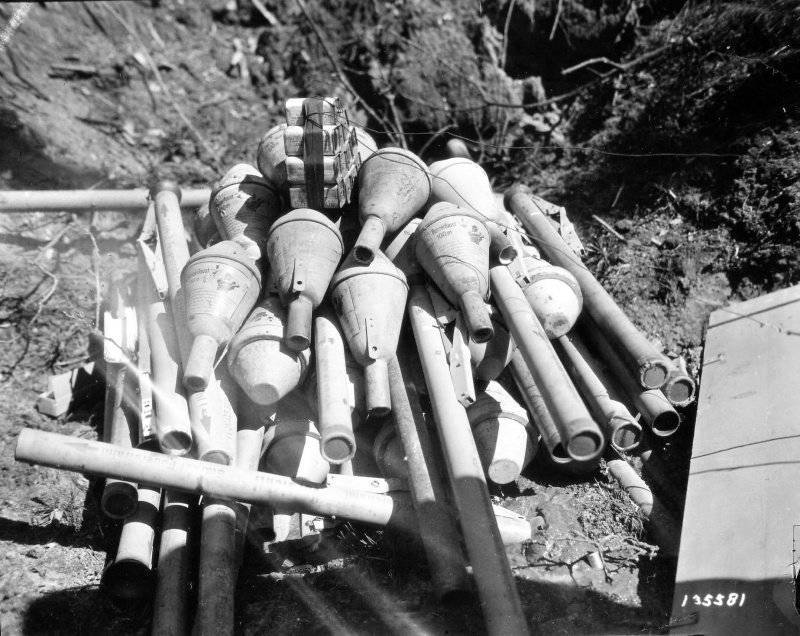
The effectiveness of the use of these weapons is indicated by the numbers of losses suffered by the Soviet tank armies in the battles at the last stage of the Second World War. For example, in April, 1945 was lost from Panzerfaust in battles on the approaches to Berlin from 11,3 to 30% of tanks, and in time for street battles in the city itself to 45 - 50%.
In general, Panzerfaust during World War II fully justified all the hopes placed on them by the command of the German armed forces. The crisis of anti-tank weapons for infantry was the reason that gunsmith designers found a fundamentally new solution to this problem - they created a complex of anti-tank weapons: RPGs and cumulative grenades. German designers thus opened a new direction in the development of weapons. Extremely effective, but at the same time cheap and simple weapons, such as grenade launchers, allowed German infantrymen to fight on equal terms with any enemy tanks in a modern, maneuverable battlefield. Although the Germans themselves, including Erich Schneider, Lieutenant-General of the Wehrmacht, believed that: "During the war, the infantry of all countries was confronted with anti-tank weapons ... However, there was no anti-tank weapon that would meet all the requirements of the infantry . The infantry needs a single person to use the anti-tank weapon, so that it can be used to destroy a tank from the 150 distance, and even better from the 400 subway. ”
But this statement can be attributed to Panzerfaust with a very big stretch, since it was they who had all the opportunities for their further improvement, and the latest models of this weapon - Panzerfaust 150 and 250М - met the requirements. It was they who became the prototypes for the creation in many countries, including the Soviet Union, of the newest type of weapons for infantry - hand-held anti-tank grenade launchers.
Melee with tanks
"Close battle with tanks" - an action movie from the command of the Wehrmacht. (Hollywood is resting). Cast - the brave Aryan guys, stupid Russian tank crews and their useless tanks. Year of manufacture - 1943. The purpose of this masterpiece is to demonstrate to housewives and boys from the Hitler Youth methods of destroying Russian tanks and their crews. Everything looks easy, understandable, simple and affordable.
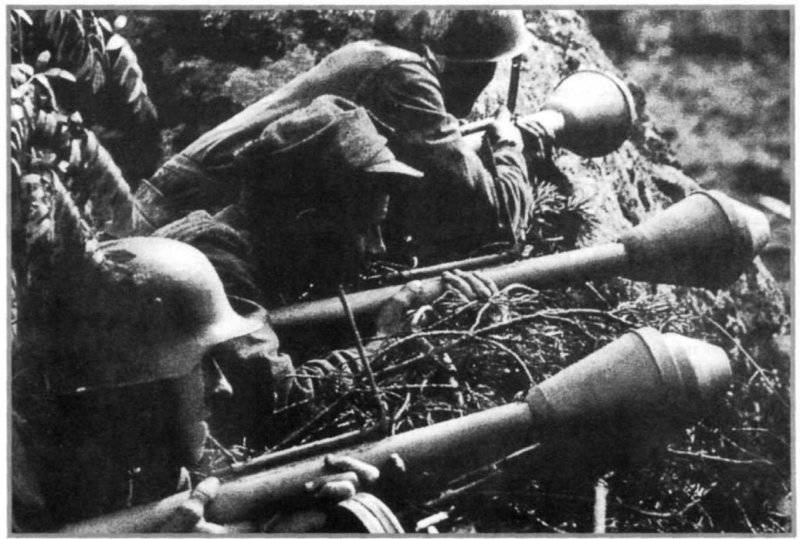


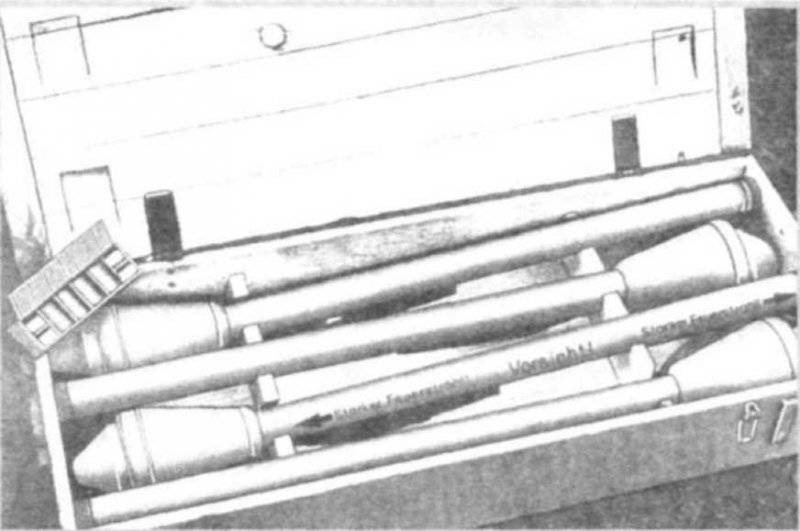

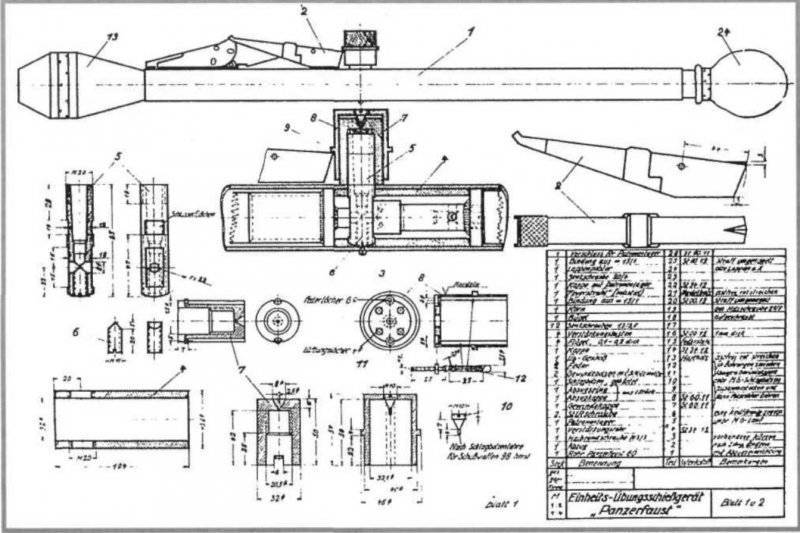
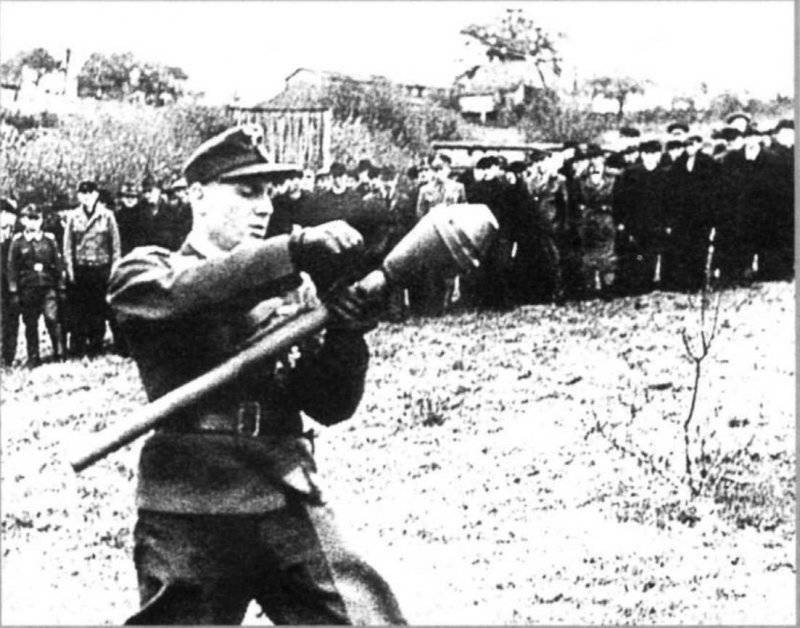
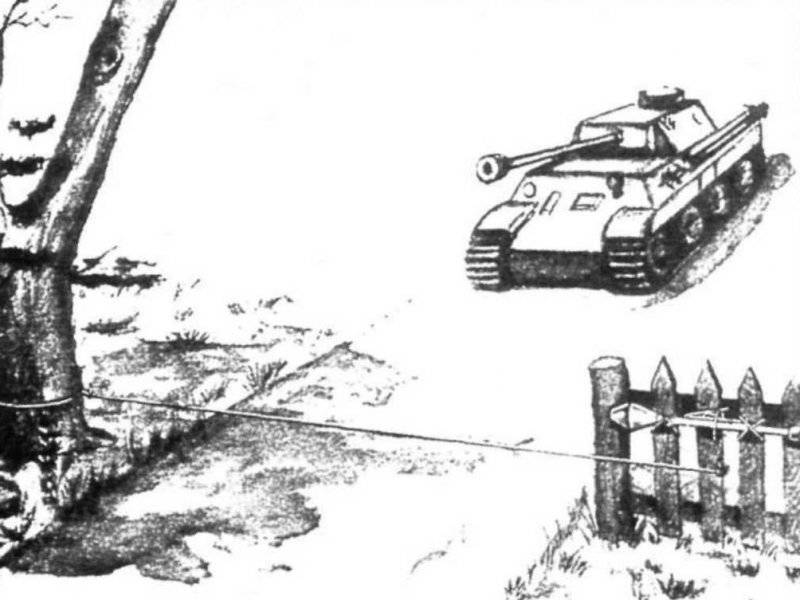
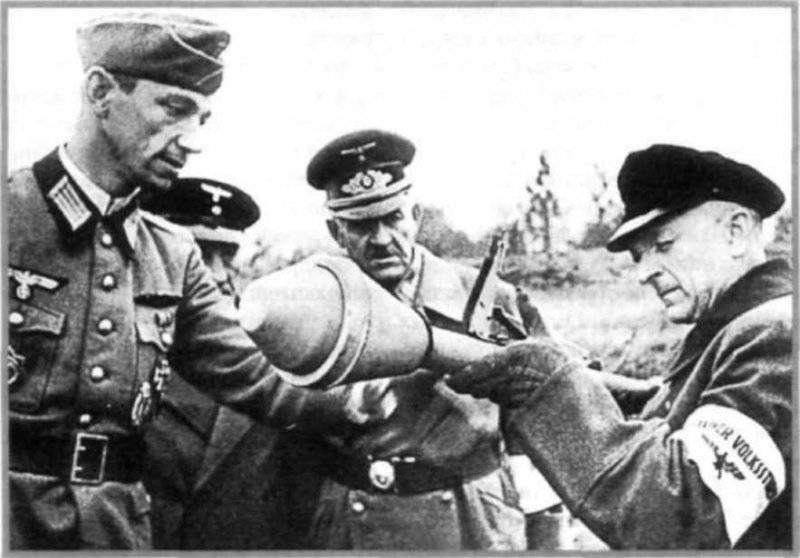
Information